A Halogenated Substance
Hazard to Self
 
Posts: 68
Registered: 7-2-2017
Location: United States
Member Is Offline
Mood: Oxidizing due to extended exposure to oxygen
|
|
Feedback for First Sulfur Chloride(s) Synth (Failure)
Alrighty, it's the weekend. Time to try something new! Why not sulfur chlorides?
Alright, so my monster of an apparatus:
![IMG_8674[1].JPG - 1.9MB](http://www.sciencemadness.org/talk/files.php?pid=474469&aid=57030)
So from left to right:
A triple neck flask with 51.6 g. (0.223 mol) of a slurry of TCCA. Above it, an addition funnel of about 10 ml. of 11.82 M HCl solution (calculated out
to be about 0.624 moles of HCl). The joints are greased with sulfuric acid.
On the right neck, we have a plastic syringe with two cotton balls and calcium chloride beads as a makeshift drying tube. A rubber stopper is used to
fit it to the flask and a taped, poorly fitting tube is on the end.
The tube leads to a flask with 10.2 g. (0.312 mol) sulfur. The tube from the 3 neck flask leads to a long glass tube that leads the path of the
chlorine down to the sulfur.
Another tube leads to a flask containing calcium chloride to help keep water from the sulfur containing flask. It also serves as a backup against
suck-back if the purple solution to the right ever gets sucked away by a pressure difference.
The beaker contains a solution of sodium carbonate, sodium thiosulfate, and phenolphthalein. The carbonate and thiosulfate solution neutralizes any
escaping chlorine, acid, or sulfur chloride vapors. The phenolthalein was used to indicate if the carbonate was ever used up by escaping vapors. I
live in a suburban neighborhood so I wanted to try not annoy people with the supposed "lovely" smells of sulfur chlorides and the odor of chlorine.
To the side, sodium thiosulfate (API fish conditioner) and sodium carbonate are kept on hand for spills. A full lab coat, safety glasses, gloves, and
a respirator were used for protection.
So now on to what I did:
1)Started dripping HCl solution into the triple neck flask. A yellow-green color formed. Continued to drip in HCl. No bubbling occured in the beaker's
solution.
2)Noticed a chlorine smell... (Guess my "drying tube" wasn't effectively sealed.
3)Tried to tighten the makeshift drying tube and seemingly succeeded. Chlorine began to enter the flask with chlorine.
4)I waited... and waited... chlorine began to enter the calcium chloride containing flask... still no sulfur chlorides 
5)20 minutes later and nothing. Disassembled the triple neck portion of the appartus. Poured in a little sodium thiosulfate solution to neutralize the
chlorine... very vigorous! Better let it vent instead.
Pictures:
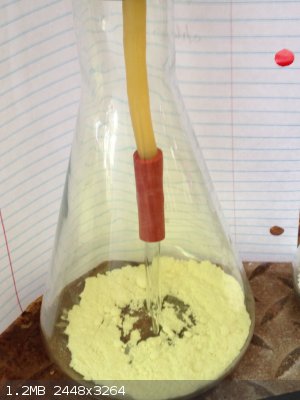
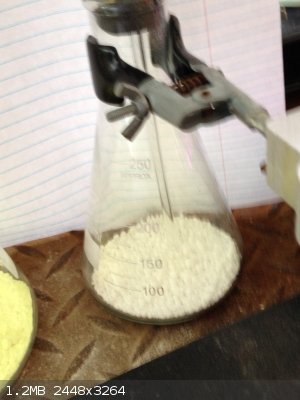
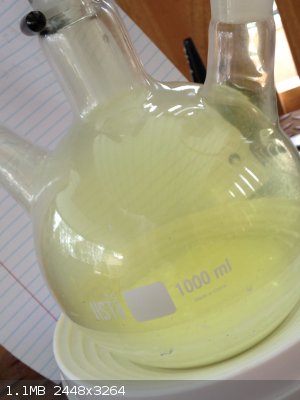 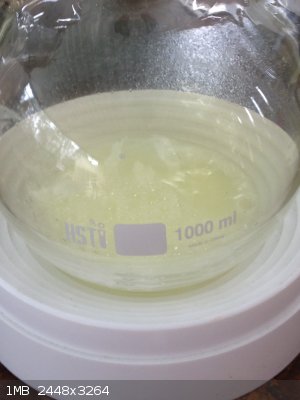 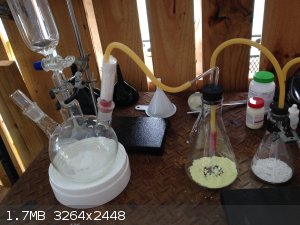 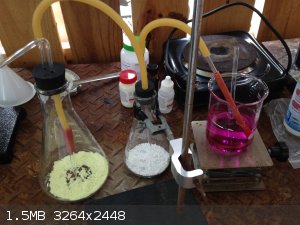 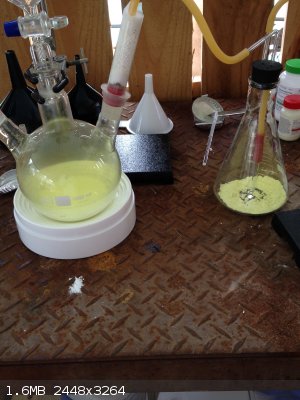
Here's when I tried neutralizing the chlorine generator with thiosulfate:
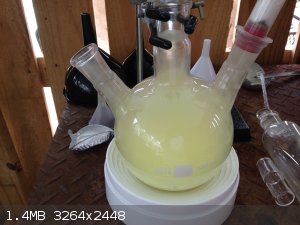
So... feedback on what I did wrong? Should I have melted the sulfur first?
I would be thankful for any feedback. 
|
|
|
elementcollector1
International Hazard
    
Posts: 2684
Registered: 28-12-2011
Location: The Known Universe
Member Is Offline
Mood: Molten
|
|
In all the preps I've seen, the sulfur was molten. Not a particularly hard fix, given the MP of 115 C.
Elements Collected:52/87
Latest Acquired: Cl
Next in Line: Nd
|
|
|
S.C. Wack
bibliomaster
    
Posts: 2419
Registered: 7-5-2004
Location: Cornworld, Central USA
Member Is Offline
Mood: Enhanced
|
|
If plastic tubing is to be used in such an application, it's to connect pieces of glass tube.
|
|
|
Geocachmaster
Hazard to Others
  
Posts: 146
Registered: 5-3-2016
Location: Maine, USA
Member Is Offline
Mood: Corroded, just like my spatulas
|
|
| Quote: |
Above it, an addition funnel of about 10 ml. of 11.82 M HCl solution (calculated out to be about 0.624 moles of HCl).
|
Correct me if I'm wrong, but I fail to see how 10ml of 11.82 M HCl contains .624 moles of HCl.
11.82 M HCl x .010 L = .1182 moles of HCl
Also, 51.6g of TCCA would require about .67 moles of HCl, not .624 (edit: this is not very significant though)
Problems like this could contribute to your failure. 6x less chlorine would definitely have an effect.
[Edited on 2/12/2017 by Geocachmaster]
|
|
|
j_sum1
Administrator
       
Posts: 6225
Registered: 4-10-2014
Location: Unmoved
Member Is Offline
Mood: Organised
|
|
Doug's Lab has the best prep I have seen for this. Watch and pinch some ideas.
https://www.youtube.com/watch?v=oYw89ieffa4
|
|
|
A Halogenated Substance
Hazard to Self
 
Posts: 68
Registered: 7-2-2017
Location: United States
Member Is Offline
Mood: Oxidizing due to extended exposure to oxygen
|
|
Quote: Originally posted by Geocachmaster  |
| Quote: |
Above it, an addition funnel of about 10 ml. of 11.82 M HCl solution (calculated out to be about 0.624 moles of HCl).
|
Correct me if I'm wrong, but I fail to see how 10ml of 11.82 M HCl contains .624 moles of HCl.
11.82 M HCl x .010 L = .1182 moles of HCl
Also, 51.6g of TCCA would require about .67 moles of HCl, not .624 (edit: this is not very significant though)
Problems like this could contribute to your failure. 6x less chlorine would definitely have an effect.
[Edited on 2/12/2017 by Geocachmaster] |
I looked back at my math and I saw my mistakes. I needed about 0.624 moles of HCl and my HCl was 11.82. Instead of dividing 11.82 by 0.624 to get 18.9
ml., I multiplied and got 7.4 in which I decided to use an excess (not realizing I was rather lacking) of 10.0 milliliters. 
What I've received from all of this:
-Get better/more glassware or change setup.
-Melt the sulfur first before introducing chlorine.
-Double check my math before jumping straight to the experiment.
I now have more planning to do.
Thank you for your responses!
Edit:Additionally, I now must find a way to get a specific isomer of sulfur chloride.
[Edited on 2-12-2017 by A Halogenated Substance]
|
|
|
JJay
International Hazard
    
Posts: 3440
Registered: 15-10-2015
Member Is Offline
|
|
You might want to use vinyl tubing instead of latex; vinyl resists chlorine better.
|
|
|
A Halogenated Substance
Hazard to Self
 
Posts: 68
Registered: 7-2-2017
Location: United States
Member Is Offline
Mood: Oxidizing due to extended exposure to oxygen
|
|
I'll probably do that in my next attempt.
I've had horrific experiences with the halogens and my rubber equipment. 
The lovely effects of bromine on a once-red rubber stopper:
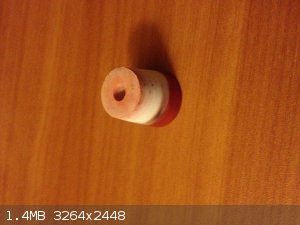
Edit:Also 3 bromine distillations and a sulfur chloride attempt later and I still haven't bought more glass equipment.
[Edited on 2-12-2017 by A Halogenated Substance]
|
|
|
gdflp
Super Moderator
      
Posts: 1320
Registered: 14-2-2014
Location: NY, USA
Member Is Offline
Mood: Staring at code
|
|
Quote: Originally posted by A Halogenated Substance  |
I looked back at my math and I saw my mistakes. I needed about 0.624 moles of HCl and my HCl was 11.82. Instead of dividing 11.82 by 0.624 to get 18.9
ml., I multiplied and got 7.4 in which I decided to use an excess (not realizing I was rather lacking) of 10.0 milliliters. 
|
Just wanted to point out that this is incorrect as well. An easy way to prevent mistakes is to label the units of each intermediate value.
$$\frac{11.82\frac{moles}{L}}{0.624 moles} = 18.9\frac{1}{L}$$
The volume should not be in L<sup>-1</sup>, it should be in L. Flipping the fraction gives the you both the correct units and the correct
answer:
$$\frac{0.624 moles}{11.82\frac{moles}{L}} = 0.0528L = 52.8mL$$
Or, using the stoichiometric value based on the amount of TCCA you mentioned:
$$\frac{0.669 moles}{11.82\frac{moles}{L}} = 0.0566L = 56.6mL$$
|
|
|
Texium
Administrator
       
Posts: 4508
Registered: 11-1-2014
Location: Salt Lake City
Member Is Offline
Mood: PhD candidate!
|
|
Quote: Originally posted by A Halogenated Substance  | I looked back at my math and I saw my mistakes. I needed about 0.624 moles of HCl and my HCl was 11.82. Instead of dividing 11.82 by 0.624 to get 18.9
ml., I multiplied and got 7.4 in which I decided to use an excess (not realizing I was rather lacking) of 10.0 milliliters.  |
Still incorrect, unfortunately. You need .624
mol, and your acid contains 11.82 mol in one liter. So, if you want to find how many mL of acid you need to use, 11.82/1 = .624/x
Isolate your variable and you get x = .624/11.82 (x1000 to convert from L to mL). Do it that way and you'll find you actually need approximately 53
mL.
Edit: gdflp beat me to it, and with a much prettier layout to boot
[Edited on 2-12-2017 by zts16]
|
|
|
A Halogenated Substance
Hazard to Self
 
Posts: 68
Registered: 7-2-2017
Location: United States
Member Is Offline
Mood: Oxidizing due to extended exposure to oxygen
|
|
Okay... apparently I need to go back and practice conversions again. 
I redid all of the math that gdflp and zts16 to make sure I made sense of it.
I got 53 ml. of 11.82 M HCl to get 0.624 moles as they had showed.
Thank you for the feedback; now I won't be over/undershooting whenever I do experiments with prepared solutions.
Yay for reader review. 
|
|
|
Amos
International Hazard
    
Posts: 1406
Registered: 25-3-2014
Location: Yes
Member Is Offline
Mood: No
|
|
Yup, the only real reason you didn't obtain sulfur chlorides was that the sulfur wasn't heated and kept molten. Your setup looks good for the
preparation, just put a hot plate under the sulfur(check out the proper reaction temperature on other preps on youtube or the forums) and update the
amount of hydrochloric acid you're using.
|
|
|
aga
Forum Drunkard
    
Posts: 7030
Registered: 25-3-2014
Member Is Offline
|
|
Excellent effort A Halogenated Substance, and thank you for posting your experiment on this website, complete with photos.
Quote: Originally posted by Amos  | | Yup, the only real reason you didn't obtain sulfur chlorides was that the sulfur wasn't heated and kept molten ... |
Not entirely sure that's true.
http://www.sciencemadness.org/talk/viewthread.php?tid=61903
http://www.sciencemadness.org/talk/viewthread.php?tid=62254
[Edited on 13-2-2017 by aga]
|
|
|
Amos
International Hazard
    
Posts: 1406
Registered: 25-3-2014
Location: Yes
Member Is Offline
Mood: No
|
|
Huh, guess I was wrong then. In my head I remembered you heating yours but clearly that wasn't the case. Maybe yours was more efficient than the one
detailed here because your u-shaped tube forced the chlorine to actually travel downward in close proximity to the sulfur? Either way, I still think
heating it is a good way to help the efficiency of the reaction.
|
|
|
aga
Forum Drunkard
    
Posts: 7030
Registered: 25-3-2014
Member Is Offline
|
|
ISTR there is an article in the Pre-Publication section or the Library where the sulphur is molten in this reaction.
It worked fine (for me) just using a u-tube and later an anti-bump head as the reaction vessel, both with cold, dry sulphur.
Shove enough chlorine into it and it quickly goes liquid.
Agitating the powder, then later the liquid (just a few minutes for it go liquid if i recall right) got the Cl2 / S to react like crazy
without much exotherm - so much so that a suck-back effect could be seen when agitating.
The OP probably didn't put enough chlorine into the reaction, although i have not checked their stoichimetry.
The resulting S2Cl2 / SCl2 mixture is nasty stuff. No point even trying to store it - i lost several pieces of
glassware trying.
If there is no immediate Use for it, best to Not make it until it is actually required.
Edit:
It was discovered later that both sulphur chloride products are Scheduled materials, and are illegal to make/acquire/posess in most parts of the
world, so best not make any at all, certainly not try to store it.
if you do choose to make a few ml to explore the science, destroy it by dumping it into a bucket of water in a well ventilated area.
That will save the loss of storage glassware, at the very least.
[Edited on 14-2-2017 by aga]
|
|
|
Amos
International Hazard
    
Posts: 1406
Registered: 25-3-2014
Location: Yes
Member Is Offline
Mood: No
|
|
Quote: Originally posted by aga  |
The resulting S2Cl2 / SCl2 mixture is nasty stuff. No point even trying to store it - i lost several pieces of
glassware trying.
If there is no immediate Use for it, best to Not make it until it is actually required. |
I've seen Praxichys and Tdep store it just fine, albeit I think in mostly-full ground glass containers with inert grease.
[Edited on 2-14-2017 by Amos]
|
|
|
aga
Forum Drunkard
    
Posts: 7030
Registered: 25-3-2014
Member Is Offline
|
|
The stuff escaped my RBF + greased ground glass stoppers, gluing the stoppers in place.
Even strong (and scary) heating couldn't budge it, so i ended up smashing the top off to get the stuff out, failed once again in a factice experiment,
then threw it all in a bucket of water.
The sulphur drops out immediately as a solid.
Naturally there is also a nasty gas and smell ...
A better chemist could probably handle/store it with no problems - not me tho !
|
|
|
A Halogenated Substance
Hazard to Self
 
Posts: 68
Registered: 7-2-2017
Location: United States
Member Is Offline
Mood: Oxidizing due to extended exposure to oxygen
|
|
I'm beginning to think that maybe I'll do this on a milliter scale and just dispose the sulfur chlorides right afterward now when I try this again...
I feel like using this stuff is asking for a lot more trouble than needed. 
|
|
|
j_sum1
Administrator
       
Posts: 6225
Registered: 4-10-2014
Location: Unmoved
Member Is Offline
Mood: Organised
|
|
Two things to try.
1. Look up aga's adventures in sulfur chlorides where he used a U tube. Looked like a simple convenient synth.
2. Look up Doug's Lab YT clip mentioned above.
Both of these will give you a good idea of how you can do this in a managed and controlled fashion. But yeah, storage is another issue.
Experimentation and then disposal in water might be easier until you have an actual use for the stuff.
|
|
|
A Halogenated Substance
Hazard to Self
 
Posts: 68
Registered: 7-2-2017
Location: United States
Member Is Offline
Mood: Oxidizing due to extended exposure to oxygen
|
|
Quote: Originally posted by j_sum1  | Two things to try.
1. Look up aga's adventures in sulfur chlorides where he used a U tube. Looked like a simple convenient synth.
2. Look up Doug's Lab YT clip mentioned above.
Both of these will give you a good idea of how you can do this in a managed and controlled fashion. But yeah, storage is another issue.
Experimentation and then disposal in water might be easier until you have an actual use for the stuff. |
One part to this is that I'm worried about the legal part of this. I'm pretty sure a police officer responding to a call and coming to the back yard
to see me producing a substance that can be used as a precursor to deadly war gases will "surely" know that I just wanted to do this for the sake of
knowledge.
I do keep a relatively decent notebook though if eyebrows are raised at me.
[Edited on 2-15-2017 by A Halogenated Substance]
|
|
|
clearly_not_atara
International Hazard
    
Posts: 2693
Registered: 3-11-2013
Member Is Offline
Mood: Big
|
|
Actually, there is a way to avoid melting most of the sulfur.
The idea is to make a "seed" quantity of S2Cl2, which is liquid at room temperature. Bubbling chlorine through this gives a relatively good yield of
SCl2. Adding more sulfur to this converts it back to S2Cl2. Then you bubble more chlorine through, add more sulfur, etc. Some acquaintances have
claimed good yields making 50+ grams with this method.
You can make the seed quantity from molten sulfur + Cl2...
...or you can heat sulfur and CuCl2 to about 414 ºC, at which point the reaction S8 + CuCl2 >> S2Cl2 + CuCl becomes favorable. Thermodynamics:
| Code: | Compound | Hf (j/mol)| S (j/mol*K)
CuCl2 (s)| -220,100 | 108.1
CuCl (s) | -137,200 | 86.2
Liquid S | +1,850 | 36.85
S2Cl2 (g)| -16,700 | 327.19 |
I have not performed this, however. Distilling hot S2Cl2 probably requires condensing it into an inert solvent such as Fluorinert, bromoform, PCBTF,
etc.
EDIT: Also, S2Cl2 is a terrible precursor for sulfur mustard. If for some reason your goal is to make sulfur mustard you're probably interested in
sodium sulfide. You can use the reaction with ethylene of course but this is high-tech and uncontrollable whereas thiodiglycol + HCl is quite easy.
Ethylamine, methylamine, phosphorus, benzaldehyde, anthranilic acid, and hydriodic acid are just as illegal but you don't see anyone worrying about
making those.
EDIT2: Also, for storage, you want to make sure that it is entirely converted to S2Cl2, possibly S2Cl2 + S, with no SCl2 remaining. The reason quite
simply is that SCl2 tends to decompose to release chlorine gas, which is likely at the root of most storage woes. SCl2 is effectively impossible to
store (because it is only stable at positive Cl2 pressures).
[Edited on 20-3-2017 by clearly_not_atara]
|
|
|